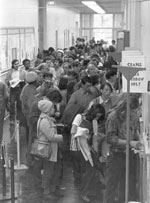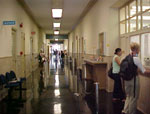|
HOME SEARCH ARCHIVE |
|
What used to be an administrative nightmare... is now a bureaucratic breeze.
By D. Lyn Hunter, Public Affairs
| |
 |
"When I first got here in 1988, I spent hours standing in various lines," said graduate student David DeGusta. "Now, I can register for classes, check my financial aid status, find out how much tuition I owe and change my mailing address, all in about 20 minutes from my computer."
Traditionally, the beginning of the school year was an administrative nightmare. But with the advent of technology, the process has become a bureaucratic breeze.
Though computers make it easier for students to take care of business, they don't run by themselves. Working feverishly behind the scenes are hundreds of staff and administrators.
"Welcoming back 30,000 students in a matter of days is not a simple task. It takes hard work by many different groups to pull it all together," said Jack McCredie, associate vice chancellor for information systems and technology and chief information officer. "The idea is to make all this effort invisible to students so that when they get here, everything is up and running smoothly."
And by all accounts, that's exactly what happened this fall. Reports from the field indicate that student needs, from financial aid to computer connections, were processed quickly, efficiently and without incident.
| |
 J.R. Schulden photo. |
Improvements were probably most noticeable at the Office of the Registrar in Sproul Hall - former home to some of the campus's longest lines - thanks to automated programs like Tele-BEARS, a computer system that enrolls some 30,000 students in classes each term.
This workhorse, introduced in 1992 as a voice response system, is also now available on the Web. What used to be a snail-paced paper process can now be completed in just a few minutes using a computer or telephone. Many students use their cell phones.
Bear Facts, established in 1997, is another line-reducing innovation, said Registrar Susanna Castillo-Robson. Using this online resource, students can change their address, look at grades or check the status of their financial aid.
"The only time we have students come to our window now is if they are having difficulties with the system or need advice on procedures," said Castillo-Robson.
Up on the second floor of Sproul, the corridors outside the Financial Aid Office are just as barren. Though the office paid out more money than ever before this fall, funds were disbursed without a hitch, said Director Richard Black. So far, nearly 12,000 students have received approximately $60 million in aid, most within a couple of days, thanks to electron- ic bank transfers.
The operation was aided by a new promissory note procedure, which requires students to sign only one note for their whole career at Berkeley, instead of one for each academic year.
Move-in day at the residence halls went smoothly as well. All 5,400 students arrived to rooms fully wired for phone, cable TV and networked computer connections. During Welcome Week, nearly 80 percent of these students had signed up for their UCLink e-mail and Computing Center accounts. This logistically complex "port-to-every-pillow" mission was made possible by the folks at Residential and Student Service Programs - Information Services.
Lines for student identification cards have drastically shrunk, due to the collaborative work of the Cal Photo ID Office and the Cal Student Orientation program. Cards were issued to 4,567 new students attending summer orientation sessions, easing the DMV-like overload that normally occurs at the beginning of the school year. During Welcome Week, the Photo ID Office extended its hours of operation to process an additional 2,067 cards.
Sometimes, transitioning requires a more face-to-face approach, like that provided by the friendly and knowledgeable staff stationed at Sproul Plaza's bright blue information tent. During Welcome Week and the first week of school, thousands of students and faculty had questions answered, said Roseanne Fong, associate director of New Student Services. Inquiries ranged from directions to buildings and the campus shuttle schedules to the ever-important "where's the bathroom?"
The backbone for most of the campus's computer transactions is provided by IST, which furnishes the infrastructure needed for databases and networking as well as main frame support. The week before classes, McCredie says his office moves into its "all-hands-on-deck" mode, making sure all systems are ready for battle. His group also rolled out "i-Drive, a new service that provides students, faculty and staff with permanent storage facilities on the Internet.
The campus effort to stamp out lines and streamline processes has been dubbed "Smooth Transition." Despite the introduction of technological advances, it has taken several years for the campus to refine its systems and for student to acclimate to a new way of doing things.
"Three years ago, we had to show students how to use the computer to register for classes," said Castillo-Robson. "Now, students are much more comfortable with the technology and it has virtually eliminated lines at our office."
Many administrators
agree that the learning curve has finally leveled out, making this year's
transition one of the smoothest on record.
[HOME] [SEARCH] [ARCHIVE] [ABOUT] [CONTACT] [MORE NEWS]
Copyright 2000, The Regents of the University of California.
Produced and maintained by the Office of Public Affairs at UC Berkeley.
Comments? E-mail berkeleyan@pa.urel.berkeley.edu.